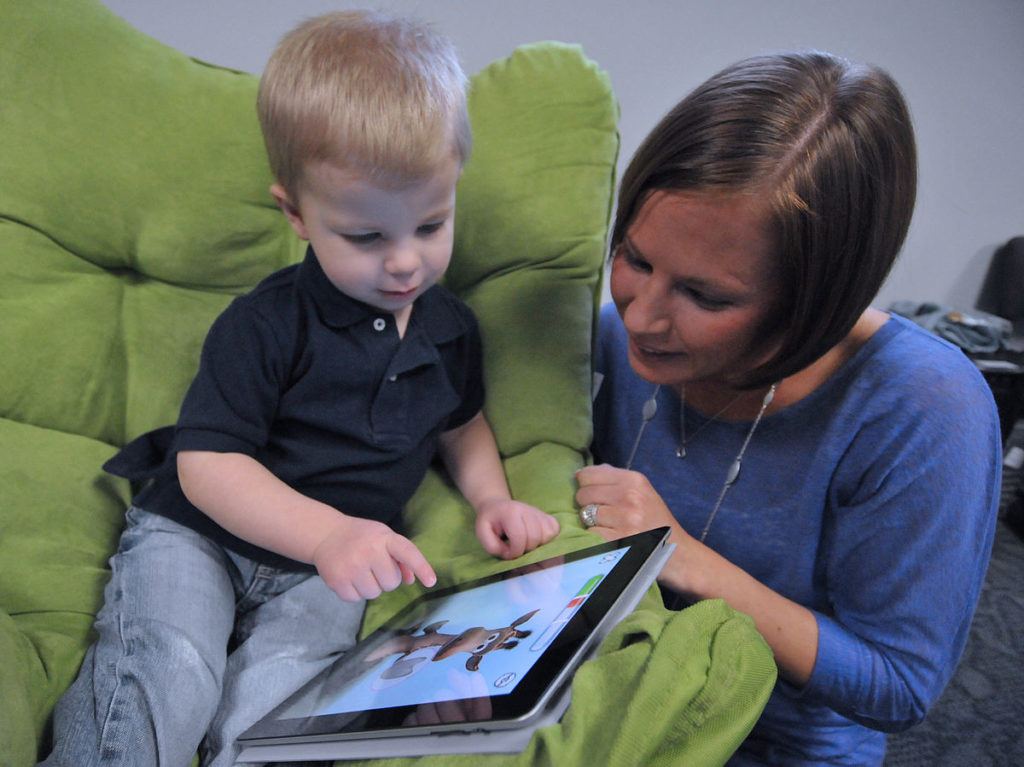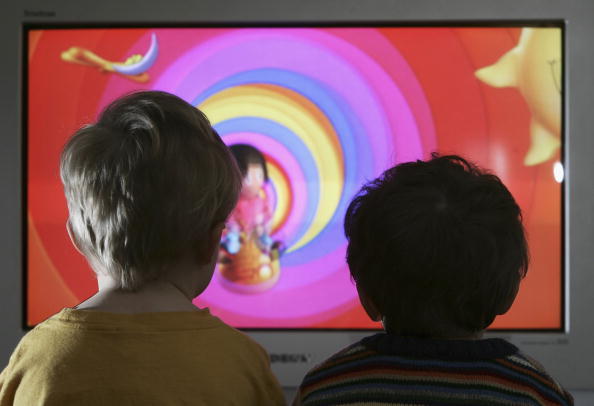children and television Credit: Peter Macdiarmid/Getty Images)

Digital technologies are evolving at breakneck speed, much faster than our understanding of the moral, ethical, physical, and social ramifications of their dominance in our lives. The first smartphone had its debut in 2007. A decade later, software can accurately read emotion from facial expressions, seamlessly manipulate video images, and invest objects with the capacity to do our bidding and cause us to love them. In market-driven economies, it’s worrisome enough that the wonders of digital technologies afford corporations endless opportunities to access and manipulate the hearts and minds of adults, but the potential harms to children are more troubling.
Babies and screens
While there’s scant evidence that babies and toddlers benefit from screens (the exception may be the family bonds strengthened through long-distance video chats with beloved relatives), children as young as preschoolers can learn from thoughtfully created television and digital content. Older children and adolescents can benefit even more. But, despite the potential benefits, the increasing prevalence of screen technologies in the lives of children is not benign.
Beginning in infancy, children around the world spend an inordinate amount of time with screens. In the United States, 37% of babies under two watch television every day. On any given day, those who watch average almost one and a half hours. In Australia, 40% of 18-month-old babies spend more than two hours a day with screens. In 2014, an international study of 9 to 11-year-olds found that they spend an average of 2.6 hours a day with screens, with children in Brazil spending the most time (3.5 hours) and children in India spending the least (1.8 hours)[1. Allana G Leblanc, Peter T Katzmarzyk, Tiago V Barreira, Stephanie T Broyles, Jean-Philippe Chaput, Timothy S Church, Mikael Fogelholm, et al. “Correlates of Total Sedentary Time and Screen Time in 9-11 Year-Old Children around the World: The International Study of Childhood Obesity, Lifestyle and the Environment.” PLoS ONE 10, no. 6: e0129622. Accessed March 6, 2018. https://doi.org/10.1371/journal.pone.0129622]. On average, preschool children in the United Kingdom spend more than four hours a day with screens, including television, online media and games. In early adolescence, that number rises to about seven hours per day[2. Children and Parents: Media Use and Attitudes Report 2017, November 29, 2017. https://www.ofcom.org.uk/research-and-data/media-literacy-research/childrens/children-parents-2017. Accessed March 7, 2018].

Developmental and health problems
These hours become more worrisome as evidence accumulates about the addictive properties of digital media[3. “The Problem.” Accessed March 8, 2018. https://humanetech.com/problem/.] [4. “Think Differently About Kids.” Accessed March 8, 2018. https://thinkdifferentlyaboutkids.com/index.php?acc=1]. A 2018 literature review in the journal Environmental Research identified several evidence-based, child-related concerns about addiction to video games, social media and the internet. New brain imaging techniques suggest that screen technologies can change the actual architecture of the brain[5. Lissak, Gadi. 2018. “Adverse Physiological and Psychological Effects of Screen Time on Children and Adolescents: Literature Review and Case Study.” Environmental Research 164 (July): 149–57. https://doi.org/10.1016/j.envres.2018.01.015].
Excessive screen time is a factor in a host of problems for children and adolescents. For children younger than two, it’s a factor in delaying language development[6. Duch, Helena, Elisa M. Fisher, Ipek Ensari, Marta Font, Alison Harrington, Caroline Taromino, Jonathan Yip, and Carmen Rodriguez. “Association of Screen Time Use and Language Development in Hispanic Toddlers: A Cross-Sectional and Longitudinal Study.” Clinical Pediatrics 52, no. 9 (September 1, 2013): 857–65. https://doi.org/10.1177/0009922813492881] [7. Media, Council on Communications And. 2016. “Media and Young Minds.” Pediatrics 138 (5): e20162591. https://doi.org/10.1542/peds.2016-2591].
Time with television and digital media are linked to childhood obesity[8. Robinson, Thomas N., Jorge A. Banda, Lauren Hale, Amy Shirong Lu, Frances Fleming-Milici, Sandra L. Calvert, and Ellen Wartella, 2017. “Screen Media Exposure and Obesity in Children and Adolescents.” Pediatrics 140 (Supplement 2): S97–101. https://doi.org/10.1542/peds.2016-1758K] as well as sleep disturbances from infancy to adolescence[9. Cheung, Celeste H. M., Rachael Bedford, Irati R. Saez De Urabain, Annette Karmiloff-Smith, and Tim J. Smith. 2017. “Daily Touchscreen Use in Infants and Toddlers Is Associated with Reduced Sleep and Delayed Sleep Onset.” Scientific Reports 7 (April): 46104. https://doi.org/10.1038/srep46104] [10. Hale, Lauren, and Stanford Guan. 2015. “Screen Time and Sleep among School-Aged Children and Adolescents: A Systematic Literature Review.” Sleep Medicine Reviews 21 (June): 50–58. https://doi.org/10.1016/j.smrv.2014.07.007]. For teenagers, time with social media is correlated with depression and anxiety[11. Twenge, Jean M. 2017. “Have Smartphones Destroyed a Generation?” The Atlantic, September 2017. https://www.theatlantic.com/magazine/archive/2017/09/has-the-smartphone-destroyed-a-generation/534198/].
In addition, much of the content children encounter on screens can be harmful. Video game violence is a risk factor for increased aggression[12. Greitemeyer, Tobias. “The Spreading Impact of Playing Violent Video Games on Aggression.” Computers in Human Behavior 80 (March 1, 2018): 216–19. https://doi.org/10.1016/j.chb.2017.11.022]. Viewing sexualised media can cause body dissatisfaction in girls as young as five[13. Slater, Amy, and Marika Tiggemann. “Little Girls in a Grown up World: Exposure to Sexualized Media, Internalisation of Sexualisation Messages, and Body Image in 6-9 Year-Old Girls.” Body Image 18 (September 2016): 19–22. https://doi.org/10.1016/j.bodyim.2016.04.004]. Children’s exposure to advertising contributes to the acquisition of materialistic values — the belief that the things we buy will make us happy[14. Kasser, Tim, and Susan Linn. 2016. “Growing Up under Corporate Capitalism: The Problem of Marketing to Children, with Suggestions for Policy Solutions.” Social Issues and Policy Review 10 (1): 122–50. https://doi.org/10.1111/sipr.12020].
A role for governments?
Evidence of harm, or potential harm, points to the need for policies that protect children from overuse. Government regulations can prevent media and tech companies from marketing directly to children, require that they provide evidence for educational claims, and hold them accountable for potential harms.
Governments can’t, and shouldn’t, legislate when, whether, and how parents expose children to screen technologies. They can, however, fund training programmes for health professionals, educators, and child development specialists to provide parents with evidence-based guidance about the potential benefits and harms of children’s time — and on how to set limits.
Concerns about the impact of screen technology on children — including the marketing it purveys so well — has for too long been the purview of concerned parents and a relatively small cadre of advocates. But that’s no longer the case.
Critique from industry – and investors
Today, public critiques of tech companies come from within the industry, citing concerns that the seductive, purposefully addictive products they create are hurting children. Two of Apple’s major investors are publicly urging the company to help parents to reduce children’s screen time. Concerned tech innovators and creators recently launched the Center for Humane Technology. In their own words, they’re taking a stand because “what started as a race to monetise our attention is now eroding the pillars of our society: mental health, democracy, social relationships, mental health, and our children”. It’s no accident that when Steve Jobs was asked what his kids thought of the iPad, he said: “They’ve never seen one.”

Love of the analogue
The way to help children flourish in the digital age is to ensure that they develop a solid grounding in, and love for, the analogue world. They need time to form powerfully deep attachments to people and connections with the rest of the natural world. To develop a healthy sense of themselves children need satisfying experiences unmediated by digital devices. They need to explore with all of their senses, and have chances to become bored enough to generate their own amusements and interests.
Proponents of a laisser-faire approach to children’s use of technology argue that we live in anti-regulatory times. Yet social movements have a long history of changing entrenched policies. They say that it’s impossible to help parents reduce children’s screen time, and all that can be done is to create ‘good’ media content. Yet research shows that interventions can help to reduce children’s screen time[15. Yilmaz, Gonca, Birlik Mahm and Kahire Cad. 2015. “An intervention to preschool children for reducing screen time: a randomised controlled trial.” Child: Care, Health and Development 41 (3): 443-449. https://dx.doi.org.ezp-prod1.hul.harvard.edu/10.1111/cch.12133].
It’s not going to be easy to stop tech and media companies from hijacking children. But given what’s at stake it’s essential that we try.










Join the discussion
Join like minded readers that support our journalism by becoming a paid subscriber
To join the discussion in the comments, become a paid subscriber.
Join like minded readers that support our journalism, read unlimited articles and enjoy other subscriber-only benefits.
Subscribe